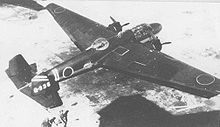Mitsubishi G3M
| Mitsubishi G3M | |
|---|---|
 G3M2 model 22, behind it a model 21 |
|
| Type: | Bomb plane |
| Design country: | |
| Manufacturer: | |
| First flight: |
July 1935 |
| Production time: |
1936-1943 |
| Number of pieces: |
1048 |
The Mitsubishi G3M Rikko ( Jap. 九六式陸上攻撃機 , dt. "Land-based attack aircraft type 96", 96 after the start of mass production in Kōki 2596, equivalent to 1936 BCE), was a Japanese bombers and torpedo bombers from the Second World War , which was also used before or at the same time in the Sino-Japanese War . The allied code name of these machines was Nell or Tina , the latter for the transport version.
history
In the 1930s developed Mitsubishi 's successful Ka-9 - reconnaissance aircraft . This was followed by the Ka-15 bomber / transporter , which formed the starting model for the G3M.
The aircraft, built by Mitsubishi Jukogyo KK, was the first heavy bomber commissioned by the Imperial Japanese Navy for the Navy Air Force . According to Mitsubishi's plans, the machine was supposed to be equipped with four engines, but the Navy opted for a twin-engine version.
The prototype first flew in July 1935. The first tests showed that Mitsubishi had developed an excellent aircraft with an excellent range. In June 1936, series production began under the designation G3M1 . This first version was created by two radial engines Mitsubishi Kinsei 3 driven, led a crew of five men and had a defensive armament of three 7.7-mm machine guns (two on the fuselage and one in the abdomen). The top speed was 348 km / h (188 knots ) and the range was 4075 km. The G3M was also designed to carry an 800 kg torpedo for attacks on ships. Only 34 copies of this first version were produced.
In 1937 the improved Kinsei 41 radial engines with 1075 hp became available, resulting in the introduction of the G3M2 Model 21 . This modified variant had an even greater range of 4400 km thanks to its enlarged fuel tanks. The new aircraft were first used on August 14, 1937 during the Battle of Shanghai , when a group of 18 G3M2s launched from Taipei attacked targets near Shanghai , more than 2,000 km away - the first transoceanic air raid in history. On August 15, 1937, eight Chinese Boeing P-26s hit six unescorted G3M2s near Nanjing and, according to their own statements, shot down the Japanese bombers without any losses of their own.
The G3M2 Model 21 was followed in 1939 by the G3M2 Model 22 with improved defensive armament (a 20 mm cannon in a large rear turret and four 7.7 mm machine guns). The team was increased from five to seven men.
After the improved successor Mitsubishi G4M (Betty) went into production at Mitsubishi in 1940 , production of the G3M2 continued at Nakajima . There, in 1941, the G3M3 model 23 version was developed with improved Kinsei 51 engines with 1,300 hp each and a further increased range of 6230 km.
The G3M, supported by some of the new G4Ms, had their greatest success when they launched the battleship HMS Prince of Wales and the British battlecruiser HMS Repulse in the waters of Malaya on December 10, 1941, three days after the attack on Pearl Harbor Force Z sunk with armor-piercing bombs and torpedoes . The Prince of Wales and the Repulse were the first battleships to be sunk solely by an air strike in the open sea.
A total of 1048 G3Ms were built by 1943 (636 by Mitsubishi and 412 by Nakajima). Several of them were converted into transport aircraft.
The G3M remained in service throughout the war, although in 1943 most were only used as reserves.
Technical specifications
| Parameter | Data (G3M3 Model 23) |
|---|---|
| span | 25.00 m |
| length | 16.45 m |
| height | 3.69 m |
| Wing area | 84.30 m² |
| Empty mass | 5,240 kg |
| Takeoff mass | 8,000 kg |
| Engine | two Mitsubishi Kinsei 51 with 956 kW (1,300 PS) each |
| Top speed at an altitude of 5,900 m |
400 km / h, fully loaded approx. 330 km / h |
| Range | 6,230 km |
| Summit height | 10,280 m |
| Armament | one 20 mm cannon four 7.7 mm machine guns one 800 kg torpedo or 800 kg bombs |
| crew | 7th |
See also
literature
- Joseph M. Horodyski: British Gamble In Asian Waters . In: Military Heritage . tape 3 , December 2001, p. 68-77 (sinking of the British battleship Prince of Wales and battle cruiser Repulse by the Japanese on December 10, 1941 before the USA entered World War II).


